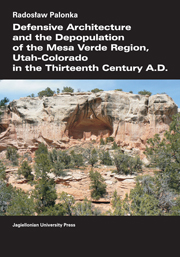Book contents
- Frontmatter
- Dedication
- Contents
- List of Figures
- Acknowledgments
- CHAPTER I Introduction
- CHAPTER II Mesa Verde region – definition, natural environment, history and methodology of research
- CHAPTER III Defining and interpreting defensive architecture
- CHAPTER IV Ethnography, ethnohistory, and Native American oral traditions concerning defensive architecture and conflicts in the Southwest
- CHAPTER V Analysis of the central Mesa Verde region architecture in the thirteenth century A.D.
- CHAPTER VI Summary and conclusions
- REFERENCES
- PHOTOGRAPHS
CHAPTER V - Analysis of the central Mesa Verde region architecture in the thirteenth century A.D.
Published online by Cambridge University Press: 05 September 2014
- Frontmatter
- Dedication
- Contents
- List of Figures
- Acknowledgments
- CHAPTER I Introduction
- CHAPTER II Mesa Verde region – definition, natural environment, history and methodology of research
- CHAPTER III Defining and interpreting defensive architecture
- CHAPTER IV Ethnography, ethnohistory, and Native American oral traditions concerning defensive architecture and conflicts in the Southwest
- CHAPTER V Analysis of the central Mesa Verde region architecture in the thirteenth century A.D.
- CHAPTER VI Summary and conclusions
- REFERENCES
- PHOTOGRAPHS
Summary
This chapter presents an analysis of fifteen large sites from the central Mesa Verde region dated to the thirteen century A.D. that probably were community centers and forty one small sites located in Lower Sand Canyon area around one of community centers, Castle Rock Pueblo. Castle Rock Pueblo and nearby small sites probably created a community of allied sites (e.g., Ortman 2008: 129; Varien 1999). The analysis of particulars sites is focusing on defensive aspects of them. This includes analysis of site location, availability of water, access to the site, site layout, and presence or not architectural features and structures that may inform us of defensive character of particular structure or the whole site (this mainly includes investigations of towers, enclosing and protecting walls, loopholes, and underground tunnels). This is completed by presenting the chronology of these sites and conclusions.
ANALYSIS OF LARGE SITES AND COMMUNITY CENTERS IN THE CENTRAL MESA VERDE REGION
I use the term “community” to refer to “social organization that defines access to necessary natural resources, provides a level of social identity for its constituent households, and serves as a significant decision-making entity above the level of the primary household unit ‘that can play’ several roles, including the definition of both land use territories and associated resource access rights for local populations within the broader regional system” (Varien et al. 1996: 100; see also Adler 2002; Varien 1999: 19–23).
- Type
- Chapter
- Information
- Defensive Architecture and the Depopulation of the Mesa Verde Region, Utah-Colorado in the Thirteenth Century AD , pp. 75 - 162Publisher: Jagiellonian University PressPrint publication year: 2011



